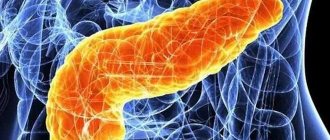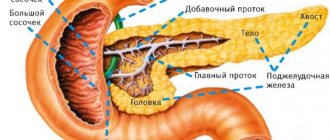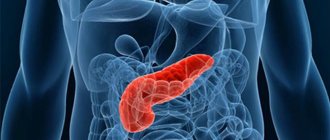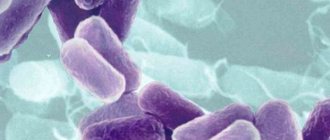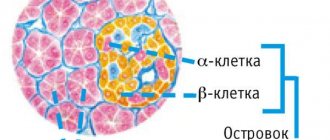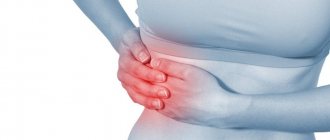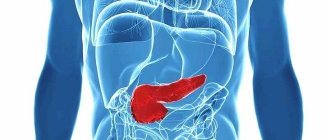If the pancreas hurts, it means that there is a disturbance in the functioning of the gastrointestinal tract. There is no medicine that can completely restore the inflamed gland tissue. It is possible to relieve exacerbation and prevent pathological changes in this important organ only with the help of dietary nutrition and a healthy lifestyle. People most often experience glandular disease after 40 years of age. In childhood and adolescence, pathology in the form of pancreatitis is rarely observed.
Functions of the pancreas in the human body
The peculiarities of the organ involved in digestion are that it consists of two functional parts:
- Exocrine (external) - produces pancreatic juice containing digestive enzymes.
- Endocrine (internal) - synthesizes hormones to regulate metabolic processes in the body (carbohydrate, fat, protein).
- Any dysfunction of the pancreas poses a threat to the entire body. If pain begins in the area where the gland is located, you should immediately seek medical help.
What is pancreatitis
Pancreatitis is an inflammatory disease of the pancreas. There are acute and chronic pancreatitis. Acute inflammation develops suddenly and disappears with adequate treatment. Chronic pancreatitis is a long-term inflammation of the pancreas, which can periodically worsen. Both forms of the disease can lead to severe complications.
Statistics
This is a fairly common problem. According to domestic clinical recommendations, in Russia, 27-50 people out of 100,000 suffer from the chronic form of the disease, and 32-389 people per 1 million suffer from the acute form of the disease.
Acute and chronic pancreatitis can affect people of any age and gender, but both forms are more often registered in men. Most patients are 30–40 years old at the time of diagnosis. It is believed that predisposition to the disease is inherited.
What happens in the pancreas
The pancreas consists of two parts that are completely different in structure and function: the exocrine, whose cells produce digestive enzymes, and the endocrine, whose cells produce hormones (insulin, glucagon and others). In a healthy organ, digestive enzymes enter the duodenum through the excretory duct and become active there. But when the pancreas becomes inflamed, they are activated in the organ itself and damage it.
- Pancreatic diseases
Nature and localization of pain
Frequent pathologies of the digestive gland are pancreatitis and the presence of calcifications (stones) in its excretory ducts. Inflammation of the pancreas can be acute and chronic, which means it can hurt in different ways. How to understand that the pancreas hurts:
- In acute pancreatitis, pain and stabbing suddenly begins in the left side under the ribs. The pain is sharp and severe, and can be tingling in nature. Antispasmodics do not relieve exacerbation. The pain in the left side of the abdomen stops only when the patient sits down and bends. The pancreas can become so enlarged that a person feels pressure on the ribs from the inside. Against the background of this condition, the breathing rhythm is disrupted.
- Exacerbation of chronic pancreatitis occurs after eating, usually after eating fatty, spicy or fried foods. The pain is vaguely aching in nature. The pain begins in the navel area, then the pain rises higher and can radiate to both hypochondriums. Prolonged pain in the pancreas may be accompanied by bloating, diarrhea, and sudden weight loss.
Knowing the signs of pain in the primary type of pancreas, you can prevent extensive damage to the tissues of the organ and prevent the transformation of acute pathology into chronic.
How to understand what exactly hurts
Pain in the pancreas of the abdomen is one reason to see a doctor. When voicing their symptoms, many do not understand that they have become carriers of a serious disease - pancreatitis.
This pathology has strong symptoms and timely assistance to the patient depends on establishing the correct diagnosis. Pain in the stomach and pancreas is not always this type of disease. These are already the consequences of side effects of other equally dangerous diseases:
- liver diseases;
- kidney disease;
- blockage of the choleretic channels and many others that affected the human pancreas.
To understand how to properly relieve pancreatic pain at home, the correct diagnosis and causes of the disease are established. Therefore, it is necessary to familiarize yourself with some examples of pain syndrome symptoms:
- Pain in the right hypochondrium – problems with the liver.
- Girdle pain, acute attacks radiate to the back or shoulder blade - choleretic problems (inflammation of the gallbladder).
- The initial impulse of pain from the solar plexus goes to the back, cutting pain under the right and left hypochondrium is a sign of pancreatic inflammation. It increases with the body position, lying down; in a sitting position, the syndrome subsides - confirmation of this conclusion.
- Bluishness around the navel, cutting pain in the upper left side of the abdomen and solar plexus - damage to the spleen.
- Periodic stabbing - cutting pain throughout the abdomen, diarrhea or constipation, blood drops in the stool - a disturbance in the functioning of the intestines.
- Aching pain in the left side of the abdomen with attacks of vomiting - gastric syndrome.
- Lower right part of the abdomen, acute pain radiating to the navel - appendicitis.
What is the pancreas and its structure? The gland is the digestive organ of the body. Its location in the human body is behind the stomach, the weight of the organ is no more than 80 g. The structure of the pancreas has a “head”, “body”, “tail”. The most common and susceptible to pancreatitis is the tail of the gland. What to do when the tail of the pancreas hurts, what are the symptoms of inflammation?
structure of the pancreas
During the inflammatory process in the pancreas, it does not always increase evenly. The most common is an enlargement of the “tail” of the gland. The enlargement obstructs the duct of the splenic vein and subrenal hypertension. What causes the pain syndrome of pancreatitis. What causes this pathology:
- the appearance of stones blocking the duct;
- appearance of a cyst (adenoma);
- inflammatory abscess of the head of the gland;
- pseudocyst;
- duodenitis of the duodenum;
- growths on the intestinal papilla;
- oncological pathologies.
According to statistics, pathology occurs from 3 cases of disease to 1 case of pathology of the tail of the pancreas. The main threat is the possible development of tail cancer. The peculiarity of inflammation is the difficulty of diagnosis, because the physiological structure of the body makes it possible to check only through the spleen or left kidney, and this is a difficult undertaking.
Symptoms of inflammation of the tail of the pancreas:
- dull aching pain in the back and solar plexus;
- pain syndrome manifests itself in the heart;
- relieves partial pain symptoms by bending forward;
- lack of appetite;
- loose stools;
- nausea often ends with severe bouts of vomiting;
- body temperature reaches 38*C, 40*C.
Why does the pancreas hurt? Main reasons
The main reasons why the pancreas hurts are poor diet and frequent intake of alcohol. These two factors, which are contributed by the person himself, can provoke necrosis - the final stage of acute pancreatitis or preceding its chronic form.
Other causes of pancreatic pain may include:
- Consequence of surgery on the gallbladder or other nearby organ.
- Injury to the pancreas. Rupture of the parenchyma of a glandular organ can occur if a person is seriously injured in a fall or strong mechanical pressure is applied to the organ (for example, in a car accident).
- Long-term use of medications. Hormonal drugs, contraceptives containing estrogen, diuretics, and an overdose of vitamin D have a negative effect on the pancreas.
- Cholelithiasis - blockage of the common channel leading to the duodenum with calcifications leads to the accumulation of pancreatic fluid in the excretory channels of the gland. This condition provokes inflammation of the organ tissue from the inside.
The question of whether the pancreas can hurt from fasting will seem strange to those people who are sure that it is hunger that allows this digestive organ to be relieved. Inflammation occurs when there is a lack of protein in the daily menu. Therefore, a diet for pancreatic disease should be prepared by a specialist.
The structure of the pancreas
Before we find out the main causes of pain in the pancreas, let's consider its structure and main functions.
The pancreas is a very important organ of the digestive system, which has a complex structure. The gland consists of 3 main parts: the head, the tail and the body itself. Externally, this organ resembles an elongated triangle and is located behind the stomach. The head of the organ rests on the duodenum, and its tail extends to the lymphoid organ - the spleen.
Anatomically, the gland is divided into lower, posterior and anterior parts. All of them are considered independent of each other.
Of course, such a division of the organ is very arbitrary.
Depending on the functions that the organ performs, it is divided into endocrine and exocrine parts. The exocrine zone of the gland makes up its bulk (about 98%) and is the source of the production of pancreatic juice, an essential substance for the functioning of the human digestive system. The secretory part produces important enzymes, such as lipase, trypsin, alpha-amylase and others, that break down and process fats, proteins and carbohydrates.
The amount and composition of pancreatic juice directly depend on the composition of the incoming food. Pastry products produce more juice containing alpha-amylase, while dairy products require less juice but higher amounts of trypsin and lipase.
The endocrine part of the gland is responsible for the production of hormones, the main ones being insulin and glucagon. These polypeptide hormones are responsible for the metabolism of carbohydrates in the body.
Diagnostic measures
If the pancreas is bothering you, then to find out the cause of the pain, you need to go to the clinic for an examination. Diagnosis of diseases of this organ is carried out using the following methods:
- Superficial palpation (palpation). In acute and aggravated chronic pancreatitis, the skin in the area of the pancreas may hurt. Tense muscles of the anterior abdominal wall indicate obvious inflammation of the parenchyma. Tension may be absent in the first stage of pancreatic disease.
- Duodenal sounding. Immersion of the probe into the main duct of the gland allows you to assess the condition of its tissues and the usefulness of the functions it performs.
- Blood and urine analysis. An increased level of pancreatic amylase in the biomaterial indicates the presence of inflammation in the gland.
- Ultrasound examination. It shows pathological changes in the structure of the gland, helps to identify cysts and tumors.
- Magnetic resonance imaging. Gives a clear picture of the condition of the ducts and tissues of the glandular organ.
- X-ray. Used to evaluate the pancreatic excretory ducts (narrowing, dilation).
Having established where the pain in the pancreas came from, the doctor chooses the direction of treatment, which is necessarily comprehensive.
Signs of organ imbalance
Pathological changes occurring in the pancreas affect all human organs. This is explained by their close relationship in the coordinated work of the human body. Dysfunction of one part immediately affects the functioning of another.
The triggered mechanism of disturbances leads to an imbalance throughout the human body.
The signs of pancreatic disease in women are the same as in men. Based on the nature of their manifestation, they are divided into several groups:
- pain symptoms;
- symptoms of indigestion;
- skin manifestations;
- specific symptoms.
Symptoms of pancreatic pain are associated with dysfunction of the organ. These manifestations are decisive and most common in the diagnosis of organ disease. Pain syndrome is provoked by inflammatory reactions occurring in the gland.
How to determine that the pancreas hurts? Of course, only a doctor can decide this, although there are symptoms by which the disease can be detected independently. When the pancreas hurts, the patient experiences dyspeptic disturbances in the functioning of the body. Pathology manifests itself with appetite disturbances in both adults and children. After eating, there is a feeling of heaviness, even if a small amount of food was consumed. Subsequently, men and women with organ dysfunction develop a feeling of nausea and gag reflexes. Often vomiting does not bring adequate relief. The bile released along with vomit turns it yellow and gives a bitter taste.
Important information: How long do people live with stage 4 pancreatic cancer?
Prolonged vomiting can lead to dehydration, which makes you feel thirsty. The resulting symptoms of digestive imbalance are aggravated by stool disturbances (diarrhea alternates with constipation) and flatulence.
In the chronic form of imbalance, skin ailments appear. This happens due to a violation of the secretion of pancreatic juice into the duodenum. As a result, the acidic environment in the intestines is not neutralized, and enzyme functioning is disrupted. Against the background of these processes, bacteria begin to actively multiply and destroy the intestinal protective barrier. Patients present with symptoms of food or bacterial allergies in the form of skin rashes or atopic dermatitis.
If, as a result of inflammatory or other processes, the volume of the pancreas increases and it begins to compress the bile ducts, then the patient’s skin may acquire a yellowish tint. So-called obstructive jaundice occurs.
Also, an enlarged organ can put pressure on the intestines, thereby disrupting blood flow in the abdominal area.
Sometimes the pancreas hurts with the manifestation of specific symptoms, which only a doctor can determine. These include:
- pain on palpation of the left costal angle (Mayo-Robson symptom);
- pain when pressing on the area below the navel 2 cm (Dudkevich's symptom);
- push-like pressure on the epigastric region of the abdomen causes severe pain (Chukhrienko's symptom);
- The Blumberg-Shchetkin symptom manifests itself as sharp pain upon palpation of various areas of the abdominal cavity.
Laboratory tests of blood and urine can reveal the presence of serious pathologies in the gland. If inflammation or destruction of the pancreas is suspected, clinical and biochemical blood tests are performed. The density of urine, the presence of proteins and leukocytes, ketone bodies and sugar are also assessed.
First aid at home for acute pain in the pancreas
First aid for acute pain in the pancreas is provided according to the following scheme:
- The patient is helped to take a comfortable lying position and is provided with complete rest.
- To relieve spasms, place a heating pad with cold water on the area where it hurts.
- If, 20 minutes after applying cold, the pancreas does not stop hurting, then before the ambulance arrives, the patient is given 1-2 tablets of No-shpa with a minimum amount of water.
When the pancreas hurts, and there is no opportunity to get medical help, the only medicine that can be used at home is No-shpa (Drotaverine). The drug can be taken to relieve acute pain for no more than 2 days in a row.
Yoga for pain in the pancreas
Many diseases are caused by abnormal changes in smooth muscle tone. These processes cannot be controlled, but by mastering several asanas that can be performed at home, you can prevent the development of complications.
Pavanmuktasana has a beneficial effect on the functioning of all internal organs and activates the functioning of the pancreas. To do this, you need to stand up straight, lower your arms, raise your right leg bent at the knee and press it to your chest. Place your left hand on your knee and grab your ankle with your right hand. Stand like this for 6 seconds, then return to the starting position. Do the same on the other leg. Perform this exercise 6 times daily.
Paschimottanasana stimulates the functioning of internal organs and has a beneficial effect on the gastrointestinal tract. You need to sit down with your legs stretched forward, lean forward and down, and reach your ankles with your hands, your head should rest on your knees, after 6 seconds we return to the starting position. Do it 3 times.
What to do if your pancreas hurts: treatment
When the pancreas suddenly begins to hurt, a person should refuse food and drink.
If possible, you should immediately go to an appointment with a local physician or gastroenterologist. The doctor will prescribe an examination, after which a health restoration plan will be formed.
Drug therapy
Only a doctor can tell you exactly how to treat pain in the digestive gland. Treating any pancreatic disease on your own is dangerous to your health. In the best case scenario, a person will experience diabetes mellitus; in the worst case, complete necrosis of the tissues of the diseased organ, followed by death. Drug therapy for pain in the pancreas depends on the type and complexity of the disease. The treatment regimen may include:
- Anticholinergics - used to relieve pain. For chronic pancreatitis, Gastrin, Pirenzepine, Gastrozipine are prescribed. In case of acute pain, as an ambulance, use Platyfillin, Metacin.
- Ringer's electrolyte solution - allows you to restore water and electrolyte balance in the body and remove toxins. Necessary if acute pancreatitis is accompanied by vomiting and diarrhea.
- Plasma substitutes (Lactasol, Ionosteril) - infused intravenously when plasma volume decreases in order to thin thick blood and restore protein metabolism.
- Antihistamines (Suprastin, Diphenhydramine, Claritin) - enhance the effect of analgesic drugs (Analgin, Baralgin), prescribed for the chronic form of the disease.
- Antibiotics (tetracyclines) are prescribed when there is a change in the structure of pancreatic tissue due to an infection that can occur as a result of injury to the abdominal organs.
- Insulin-glucose therapy - insulin is administered subcutaneously in case of insulin deficiency. This hormone is necessary for carbohydrate metabolism; it is produced by the endocrine part of the gland; intravenous glucose is needed during therapeutic fasting.
- Anabolic steroids (Methandrostenolone, Retabolil) are prescribed to patients who have suddenly lost weight in order to increase the absorption of protein by their body. The drugs increase appetite, promote weight gain, and improve overall health.
- Enzyme medications (Creon, Festal, Pancreatin) - temporarily provide rest to the pancreas and normalize the digestive process.
- Vitamins - in the chronic form of the disease, vitamins of group B, A, C are prescribed orally or intravenously.
After relieving pain in the area of the digestive gland, the patient is recommended, in order to increase the duration of remission, to go to a sanatorium-resort treatment or to a gastroenterological sanatorium.
Diet
In the first days of the disease, the patient is prescribed therapeutic fasting with drinking still mineral water and rosehip decoction. As soon as the patient begins to recover, he is allowed oatmeal. When the pancreas stops hurting, he is switched to a diet containing only dietary fats.
The menu for a person with a diseased pancreas includes:
- first courses with vegetable broth,
- slimy porridges (oatmeal, rice, barley),
- dietary meat (veal, rabbit, chicken), low-fat fish (cod, pollock, flounder),
- stewed vegetables (potatoes, pumpkin, zucchini, carrots, beets, cauliflower),
- low-fat fermented milk products (cottage cheese, kefir, fermented baked milk, hard cheese), unsalted butter, skim fresh milk for making porridge,
- dried wheat bread,
- fruit and berry juices (currants, cherries, pomegranates), weak black or herbal tea without sugar.
Coffee, baked goods, fatty and fried foods, smoked foods, marinades and pickles, and sorrel are excluded from the menu. A diseased organ can begin to hurt even from mushrooms and root vegetables. For pancreatic diseases, drinks that contain alcohol are strictly contraindicated.
Traditional medicine methods
Traditional methods of treating pancreas are best used after consulting a doctor. When using home remedies, there is always the possibility of side effects, which usually include an itchy rash on the skin and deterioration of the digestive tract. The kidneys may suddenly begin to hurt or liver failure may occur.
Milk for pain in the pancreas
How to prepare: rinse 100 g of oats, fill completely with warm water, place in a warm, dark place for 2 days. The oats will sprout. It needs to be dried and ground into powder, then dried again. Then 1 tbsp. l. oatmeal pour 200 ml of cold water. Bring the thoroughly mixed mixture to a boil over medium heat.
How to use: the medicine from sprouted oats should be taken warm 20 minutes before meals (2 times a day).
Result: with regular consumption of oat milk, the pancreas stops hurting. Oats have an anti-inflammatory and antispasmodic effect and help improve carbohydrate metabolism in the gland.
Curdled milk compress for acute pain
How to make: a thin cotton sheet is soaked in cold curdled milk.
How to use: the compress is placed so that it covers the epigastric region and left hypochondrium. The compress is covered with a plastic bag. Wrap the painful part of the body with a warm scarf. The duration of treatment for the digestive gland is at least 4 weeks.
Result: the compress relieves pain, inflammation, and helps restore gland function. It stops hurting due to irritation of the skin with a compress, against the background of which vascular tension in the diseased organ changes, secretory activity is normalized, and metabolism in cells improves.
Medicinal porridge for breakfast
How to cook: in the evening 1 tbsp. l. buckwheat flour (you need to grind the buckwheat yourself), pour in 250 ml of low-fat kefir, mix thoroughly, cover and leave until morning.
How to use: medicinal porridge should be eaten for breakfast. Also during the day you need to drink tea, which is prepared from the same parts of elecampane root, St. John's wort, peppermint, dried cucumber, dill seeds, coriander (pour 1 tablespoon of the mixture into 250 ml of boiling water).
Result: a therapeutic breakfast and herbal tea relieve acute pain in the pancreas and provide long-term remission. The recipe is used until the gland stops hurting completely.
Main symptoms of pancreatic disease
How the pancreas hurts in a person, the symptoms of its inflammatory processes and the nature of the pain are different for each patient.
If you feel even the slightest heaviness in the area of the left hypochondrium, or, as they say, in the pit of the stomach, you should think about it, especially if these sensations are not fleeting and not one-time.
The organ initially reports a problem through pain. Its nature and the presence of other manifestations depend on many factors: body structure, age, the presence of concomitant diseases, the form of the underlying disease, etc.
It can be paroxysmal, exhausting and constant, radiating to the back, under the shoulder blade, and to other neighboring areas. As a rule, pain appears after eating. Aggressive food and alcohol especially contribute to organ dysfunction.
You should focus on general criteria.
The main symptoms accompanied by pain of pancreatic disease in people can be called:
- Pain in the ribs, heart;
- Heaviness and pain in the stomach after eating “aggressive” food;
- Periodic increase in temperature;
- Nausea, vomiting, intestinal disorders;
- Loss or decreased appetite.
It is extremely difficult to independently determine the real source , because the symptoms are similar to other diseases of the internal organs present in the patient’s history.
This makes it difficult to correctly assess the situation and prescribe adequate treatment without additional examinations.
Disease prevention
To prevent the pancreas from starting to hurt again after treatment, you must:
- Stop drinking alcohol.
- Eat properly.
- Lead a healthy lifestyle.
- Take vitamins to strengthen your immune system.
- Avoid strenuous physical activity.
- Periodically undergo examination by a therapist or gastroenterologist.
Prevention of pancreatic diseases is a measure that helps prevent exacerbations and complications of the disease, and also helps improve the health of people with chronic pancreatitis.
1
